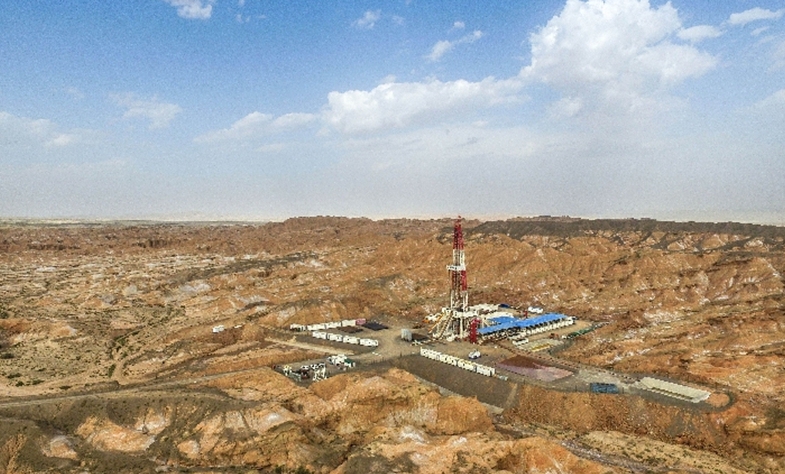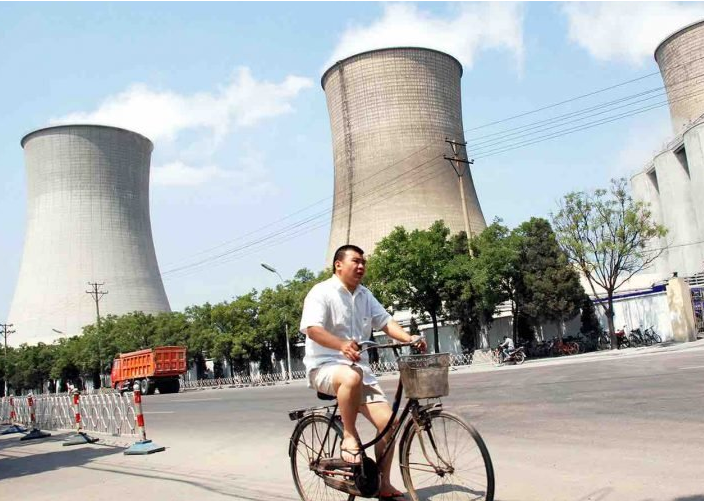
Global electricity production from coal is on track to fall by around 3% in 2019, the largest drop on record. This would amount to a reduction of around 300 terawatt hours (TWh), more than the combined total output from coal in Germany, Spain and the UK last year.
The analysis is based on monthly electricity sector data from around the world for the first seven to 10 months of the year, depending on data availability in each country.
The projected record is due to… Record falls in developed countries, including Germany, the EU overall and South Korea, which are not being matched by increases elsewhere. The largest reduction is taking place in the US, as several large coal-fired power plants close.
A sharp turnaround in India, where coal power output is on track to fall for the first time in at least three decades.
A flattening of generation growth in China.
The main counteracting force is from continuing increases in coal generation in south-east Asia, but demand from these countries is still small relative to the global total.
The global decline means an economic hit for coal plants due to reduced average running hours, which are set to reach an all-time low.
The record drop also raises the prospect of slowing global CO2 emissions growth in 2019. Nevertheless, global coal use and emissions remain far higher than the level required to meet the goals of the Paris Agreement.
Record decline
After decades of near-uninterrupted growth (blue line in the chart, below), our analysis suggests global electricity production from coal is on track for a record fall in 2019 (red bar, lower panel).
Generation for the year is projected to come in 3% below the level in 2018, a reduction of some 300TWh.
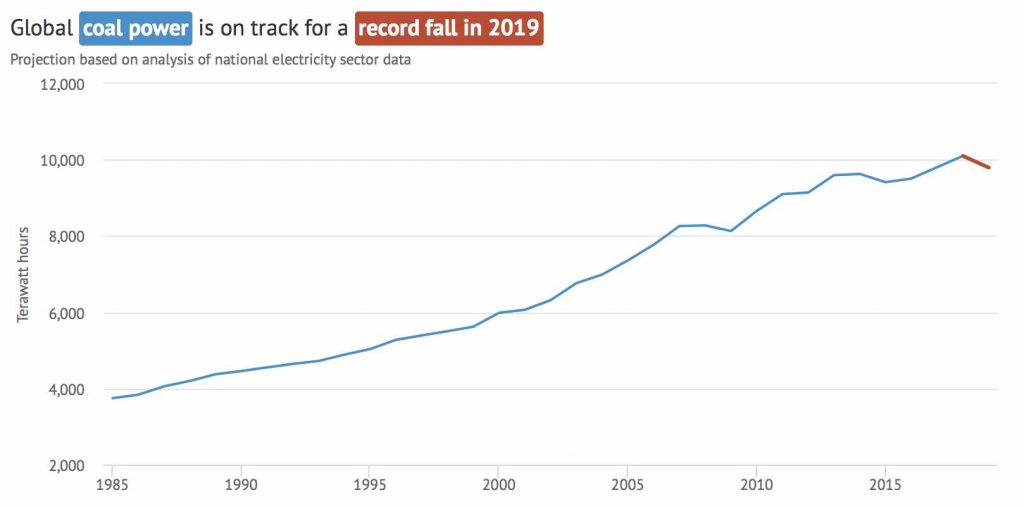
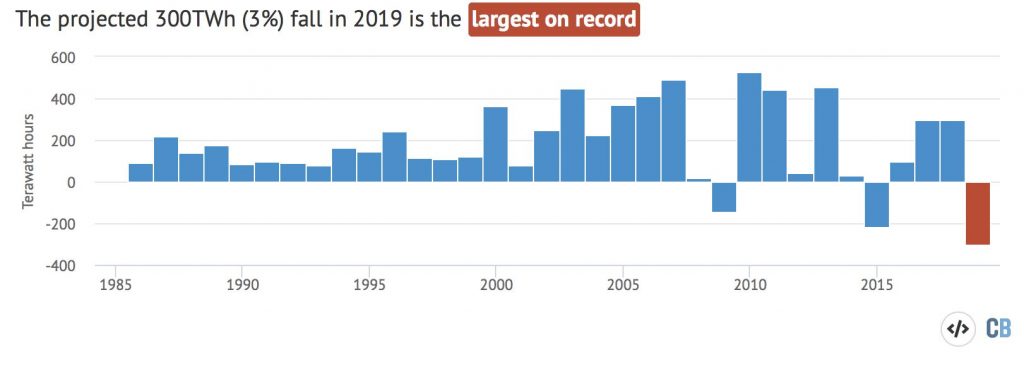 Global coal-fired power generation (above) and year-to-year change (below) in terawatt hours. Source: BP Statistical Review of World Energy and authors’ analysis of monthly electricity generation data from around the world. Chart by Carbon Brief using Highcharts.
Global coal-fired power generation (above) and year-to-year change (below) in terawatt hours. Source: BP Statistical Review of World Energy and authors’ analysis of monthly electricity generation data from around the world. Chart by Carbon Brief using Highcharts.
In the past three and a half decades, only two other years have seen declining coal power output: a fall of 148TWh in 2009 in the wake of the global financial crisis; and a 217TWh cut in 2015 following a slowdown in China.
Perfect storm
The reasons for the historic projected drop in coal-fired generation in 2019 vary from country to country, but include increased electricity generation from renewables, nuclear and gas, as well as slowing or negative power demand growth.
Across the developed countries that make up the OECD, there has been strong growth in wind and solar generation in 2019, as well as reductions in electricity demand related to slower global economic growth and trade (top left panel in the chart, below).
Falling demand is particularly clear in Japan and South Korea (part of OECD Asia Oceania, bottom left), where exports have dropped sharply.
In both countries, nuclear generation increased substantially, pushing down coal use. In North America, about 60% of the fall in coal came from switching to gas, as coal plants closed and new gas plants opened (top right).
Changes in power generation in Jan-Jul 2019
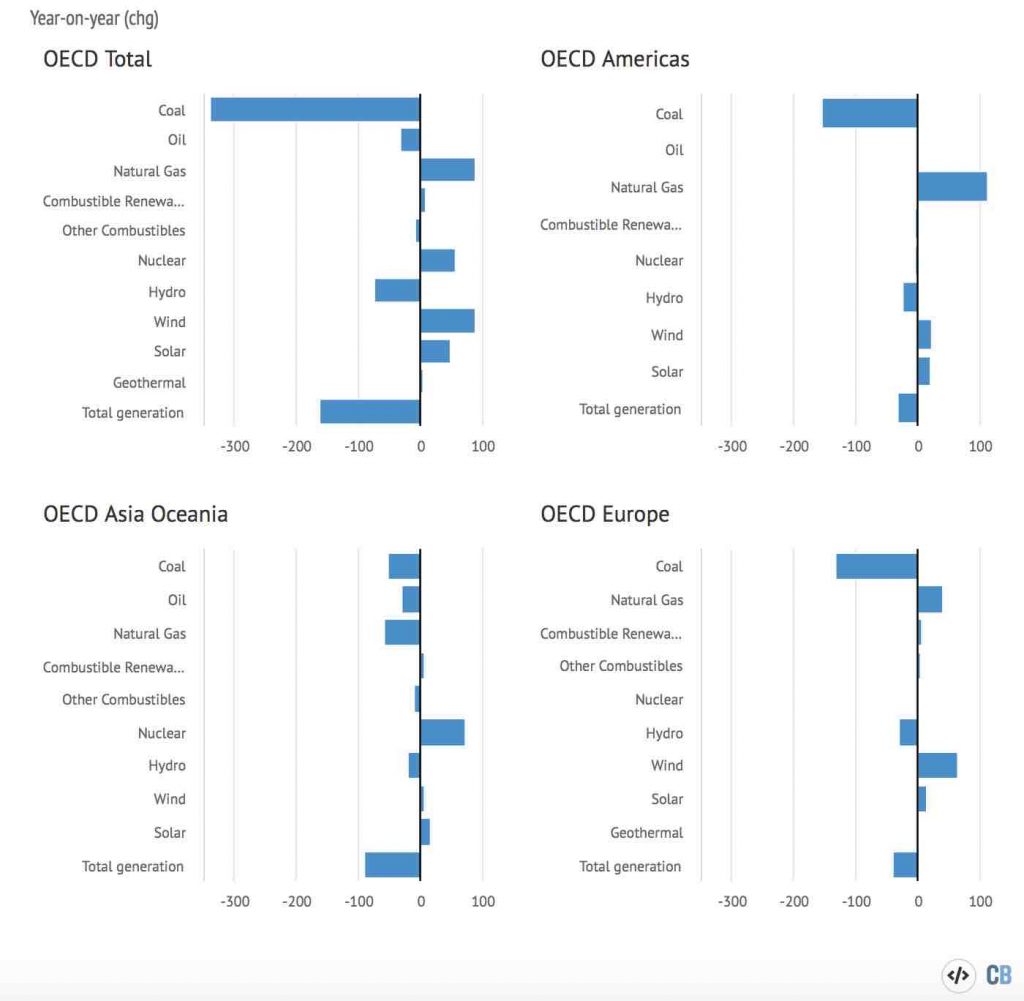 Change in electricity generation by source in all developed OECD countries combined (top left panel, terawatt hours) and in each OECD region (other panels). Data covers the first seven months of 2019, compared with the same period in the preceding year. Source: International Energy Agency. Chart by Carbon Brief using Highcharts.
Change in electricity generation by source in all developed OECD countries combined (top left panel, terawatt hours) and in each OECD region (other panels). Data covers the first seven months of 2019, compared with the same period in the preceding year. Source: International Energy Agency. Chart by Carbon Brief using Highcharts.
Over the preceding two years 2017-2018, reductions in coal generation in the US and EU have been offset by increases elsewhere, particularly in China.
This year, however, the fall in developed economies is accelerating, while coal generation in India and China is slowing sharply, precipitating a global reduction.
What is happening – county by country
China
In China, electricity demand growth has slowed to 3% this year, down from 6.7% over the past two years. Non-fossil energy sources have met almost all this demand growth.
The country’s demand for coal-fired power depends on the interplay between clean electricity growth and rising demand. The gap between the two, if any, is filled with coal.
This means that when electricity demand is growing strongly, coal dependence comes to the fore. With these conditions, 2017-2018 saw coal-fired power generation grow at an average of 6.6% year on year.
However, 2019 has so far seen strong nuclear, wind and hydro power generation and relatively weak overall electricity demand growth, with coal use in electricity flatlining.
At the same time, Chinese power firms have been continuing to add new coal-fired power plants to the grid at a rate of one large plant every two weeks. This has driven coal-fired power plant utilisation rates – the share of hours in the year when they are running – back down to record lows of 48.6%.
This is the fourth year in a row that the Chinese national average has been below 50% – and also below the global average, which stands at 54%.
Back in 2012, the International Energy Agency (IEA) said: “China is coal, coal is China.” Fast forward to 2019 and the country still dominates the global picture for the fuel.
As coal-fired generation has declined in Europe and the US, China’s dominance in power sector coal use has increased and is set to reach a record 48.1% of the global total in 2019. China is the world’s largest coal producer, consumer and importer.
However, 2019 has also seen the first contracts for wind and solar plants that will generate power at the same price as coal power plants, putting China on a path to renewable energy “grid parity” as those projects come online in 2020.
US
The US is on track this year for one of its largest annual declines in coal-fired power generation. Year-to-date August 2019, coal-fired power is down 13.9% compared with the same period in 2018. The month of August 2019 saw coal-fired power generation down 18.2% year-on-year.
Coal unit retirements have continued this year at near record rates. Year-to-date data shows 57 units, with a capacity of 14.0 gigawatts (GW), that are all retiring in 2019 – some 5.8% of the US coal fleet. This compares with 15.5GW (6.0%) of retirements in 2018.
India
Electricity demand growth in India has continued to slow dramatically across the first ten months of 2019. In October, electricity demand actually fell by 13.2% against the same month last year.
Collectively, power from all non-coal sources grew by about 12% in January-September, leading to a downturn in coal-fired generation that is accelerating sharply. Coal-fired generation in October fell by 19% year-on-year to the lowest level since 2014.
Heavy monsoon rains have affected industrial power demand, but as demand has continued to plummet in November, a broad slowdown in industrial output is becoming increasingly apparent.
This suggests that the country’s CO2 emissions growth is slowing further from the already low annual rate of 2%, which we estimated from data for the first half of 2019.
The average thermal power plant utilisation rate in India is below 58%, meaning substantial idle coal capacity.
EU
The European Union has experienced an unprecedented 19% year-on-year decline in coal-fired power generation in the first half of calendar year 2019. This is accelerating in the second half of the year to an estimated 23% fall in 2019. Around half the fall in coal reflects the impact of new wind and solar. The other half is due to a switch from coal to gas.
The coal-gas switch has happened as the carbon price in the EU Emissions Trading System rose above €20 per tonne of CO2 and gas prices fell, pushing gas generation to be cheaper than coal throughout 2019.
Because very few new gas plants are being built in Europe, further coal-gas switching will be constrained in subsequent years.
The expansion of wind and solar is increasing, however, and this will be the driving factor displacing not only coal generation, but also output from gas in the future, as long as demand growth remains tepid or negative.
All western European countries have seen big percentage falls of coal use – from 22% year-on-year in Germany to 79% in Ireland – in the first half of 2019.
There were times of zero or near-zero coal generation in many western European countries.
For example, coal has been less than 2% of the electricity mix in Ireland, France and the UK, and only 6% in Spain and Italy, across the first half of 2019. The UK had two weeks in May with all its coal plants switched off for the first time since the Industrial Revolution began.
Germany has seen by far the biggest cut in coal generation in absolute terms, with both hard coal and lignite falling substantially.
The falls in central and eastern European countries have been much smaller, due to near-zero installations of wind and solar, as well as limited gas-fired capacity.
Out of the 17,000 megawatts (MW) of renewables installed across Europe last year, Poland accounted for just 39MW, Czechia 26MW, Romania 5MW and Bulgaria 3MW.
Coal use fell 6% in Poland as a new gas plant at Plock came online and fell 16% in Greece as gas generation picked up. In Slovenia and Bulgaria, coal generation rose slightly.
South-east Asia
South-east Asia is often quoted as being a driver of growth for the global coal industry. Other than Indonesia, itself a major coal producer, south-east Asia is certainly a region that is increasingly reliant on imported thermal coal. The IEA Renewables 2019 report highlights how the region lags behind the rest of the world in diversifying into renewable energy.
However, there are some signs that this is changing. For example, Vietnam saw a tenfold increase in total solar installed over the past 12 months.
Nevertheless south-east Asia is expected to see coal-fired power generation growing at 10% in 2019, given the commissioning of a number of new coal plants started earlier this decade. The largest increase this year comes from Vietnam, where coal imports have doubled, while domestic coal output has increased 10% in the first 10 months of 2019.
South Korea
South Korea’s thermal coal imports in the year to July were down 10% year-on-year and the IEA reports coal-fired power generation in the same period to be down 9.8%, putting the country on track to a record reduction in coal-fired power.
This is due to a range of factors including increased nuclear power generation and a 28% increase in the country’s coal tax to US$40 per tonne, imposed in April 2019.
The national emissions trading scheme, introduced in 2015, has also had an increasing impact, as have seasonal coal plant closures due to extreme air pollution.
In 2018, South Korea was the fourth largest coal-importing nation globally, behind China, India and Japan. However, the South Korean government has proposed increasing the country’s renewable electricity target up to 30-35% by 2040, a rise from 8% today.
Other countries
South Africa’s total power generation fell 1.5% in January-August. In Russia, thermal power generation increased by 1.6% in January-September, both slowing down from 2018.
Japan has seen thermal coal imports in January to September 2019 fall 3.5% year-on-year to 82m tonnes – including a dramatic 8% year-on-year decline in the first seven months – reflective of electricity demand that is relatively flat and rising nuclear power generation.
Idle capacity
The global average utilisation of coal-fired power plants is on track to hit an all-time low this year, affecting the profitability of both existing and planned capacity.
The chart below combines our projection for coal generation in 2019 (black line) with capacity figures from the Global Coal Plant Tracker (blue), to show that while the world is adding new coal-fired power plants, their average utilisation rate is in decline (red).
Global coal generation is on track for a record fall in 2019
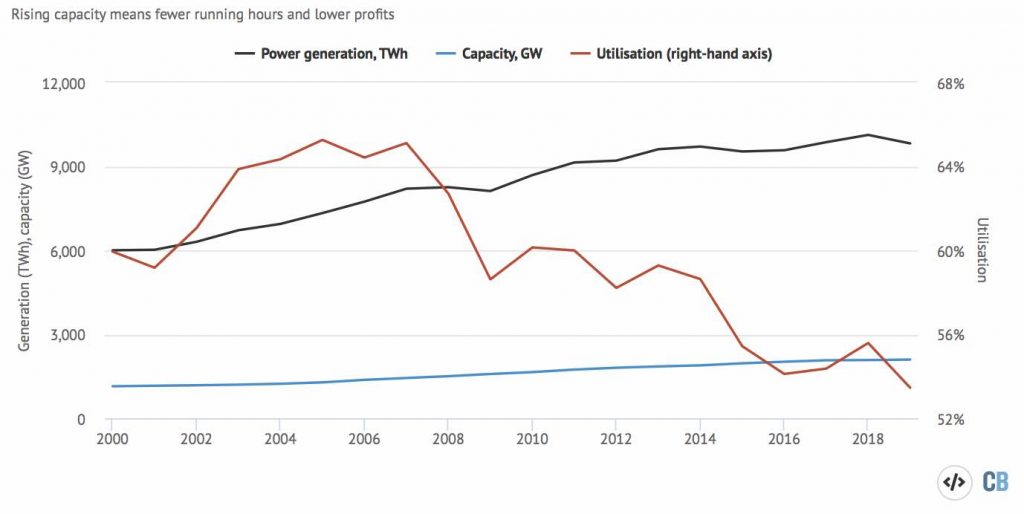 Total capacity of the world’s coal-fired power plants (blue line, gigawatts, GW, left axis), total annual electricity generation from coal (black, terawatt hours, TWh, left axis) and the average utilisation (red, percentage of time that the capacity is operating, right axis). Sources: Global Coal Plant Tracker, IEA database, authors’ analysis. Chart by Carbon Brief using Highcharts.
Total capacity of the world’s coal-fired power plants (blue line, gigawatts, GW, left axis), total annual electricity generation from coal (black, terawatt hours, TWh, left axis) and the average utilisation (red, percentage of time that the capacity is operating, right axis). Sources: Global Coal Plant Tracker, IEA database, authors’ analysis. Chart by Carbon Brief using Highcharts.
The chart shows that after a peak of 62% in 2011, the average coal plant in 2019 is likely to have been operating only 54% of the time.
As well as affecting the profitability of individual coal plants, such a low utilisation rate also implies that the electricity they generate is more expensive, as capital costs are paid for by output during fewer running hours.
Global outlook
Global coal use peaked unexpectedly back in 2014, at a time when the IEA was still forecasting rising demand beyond 2030.
This peak was driven in large part by a reduction in China’s coal-fired generation, as a result of a slowdown in construction and heavy industry output and a rapid increase in hydropower, wind, nuclear and solar output.
With China’s strong growth in electricity demand during 2017-18 driven largely by the uplift in output in traditional heavy industry – steel, cement, flat glass – and property sectors, thermal coal use globally increased as a result in 2017 and 2018, driving the fastest increase in CO2 in seven years.
But the rapid increase in non-fossil sources of power, CO2 pricing and coal-plant retirements, assisted by a global economic growth slowdown, are pointing towards coal-fired power generation experiencing a record year-on-year decline in 2019.
The direction of coal-fired power output has significant implications for global efforts to tackle climate change. in 2018, a 3% increase in CO2 emissions from coal-fired power generation was responsible for 50% of the global increase in emissions from fossil fuels.
For 2019, a 3% reduction in power sector coal use could imply zero growth in global CO2 output, if emissions changes in other sectors mirror those during 2018. Reducing coal-fired power generation will also play a central role in meeting global climate goals.
While coal plants are responsible for 30% of emissions from the energy sector, reductions in their CO2 output make up 60% of the cuts between 2018-2040 in the IEA “Sustainable Development Scenario”, which limits warming to well-below 2C.
In that scenario, coal-fired power generation falls by 6%, on average, every year for the next two decades. This can be compared to the more modest 3% reduction projected for 2019.
Methodology
Data on coal-fired power generation was compiled from national statistical offices and from the IEA for OECD countries. When coal-fired generation was not reported, proxies, such as thermal power generation, coal imports and total power generation, were used.
Uncertainty ranges were assigned for development during the remaining months of 2019 not covered by data, based on variances in past years’ coal-fired power generation.
Uncertainty for the countries not covered by our data (“rest of the world”) was assigned based on the range of past growth rates.
Global generation growth was calculated by weighing national and regional growth rates with 2018 generation from the BP Statistical Review of World Energy. The uncertainty range was calculated assuming national growth rates are independent random variables.
The projected changes and associated uncertainty in global coal power generation is shown in the chart below (leftmost column and whiskers), with changes for individual countries and regions shown in the remaining columns.
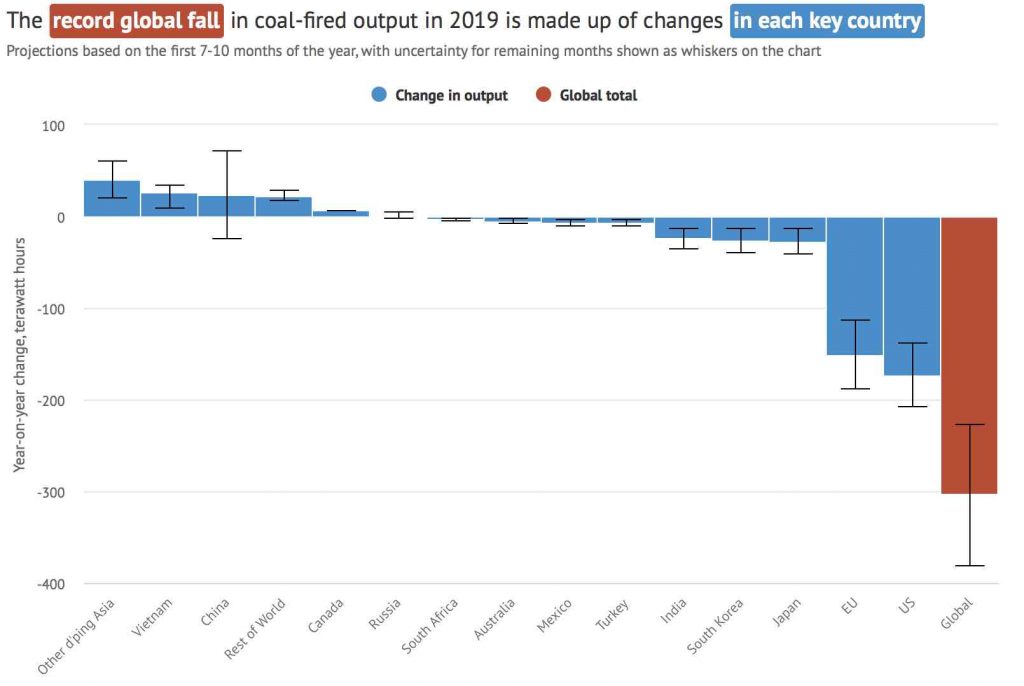 Source: Carbon Brief. Reproduced with permission.
Source: Carbon Brief. Reproduced with permission.



